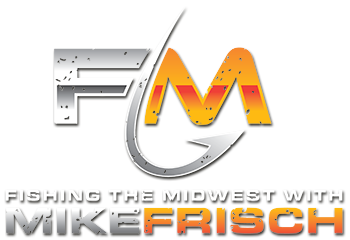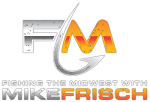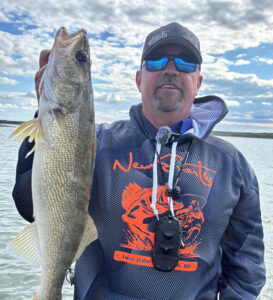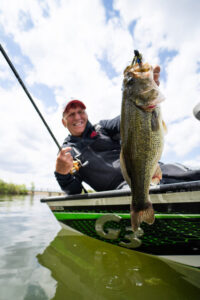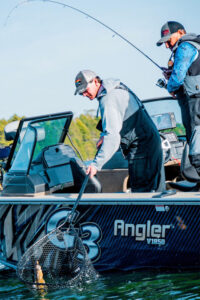By Mike Frisch and the Fishing the Midwest team
If you fish waters holding largemouth bass during the summer, there will be some bass living on what’s referred to as the weedline. Here are some ideas for catching those bass.
The weedline usually refers to the outside edge of weeds where they stop growing. On different lakes it will be found in different depths. In clear water lakes,the weedline will be deeper, fourteen or sixteen feet might be an average weedline depth in lakes that have clear water. However, it may be even deeper in really clear water.
In stained water lakes the weedline might only be seven or eight feet, and the weeds might be sparser.
In addition to a deep weedline, there will be a shallow or inside weedline too. A typical weedbed might lay out this way: You start out from the shoreline and it’s mostly a sand bottom, but there might be some scattered weeds. Then at say about five feet, the weeds get thicker, this is the inside weedline. As the water gets gradually deeper, the weeds usually get thicker. This is the weedbed. As you go deeper, eventually the weed growth will stop. That’s the deep edge of the weedbed, or what’s commonly called the weedline.
On cloudy days or early in the day, the bass will be on the shallow edge of the weeds, the inside weedline. A spinnerbait buzzed over the tops of the shallow weeds will be productive, but fish the spinnerbait slower if the bass don’t respond. A skirted bass jig tipped with a Rage Swimmer will also produce. This combination is often called a swim/jig and in the past several years bass-chasers have learned that swimming a skirted jig tipped with plastic and worked kind of like a spinnerbait is a very good way to catch largemouth bass.
During mid-day, the bass activity will usually be better on the deep weedline. The bass will be scattered along the weedline and grouped on points and pockets on the weedline. As you work along the weedline you’ll find that you can catch one here and another there, but when you come to a point or pocket or some sort of irregularity, you’ll catch several.
There are lots of ways to catch bass along the deep weedline, but it’s hard to beat a crankbait and a small jig/worm combination. The crankbait will catch the active fish and is a great “search” lure. The jig/worm fishes slower but is a really good lure for maximizing the catch when a school of bass is located.
Many different species of fish live along the weedline, and although bass might be the target, you’ll probably catch some walleyes or northern pike and every now and then maybe a crappie or a musky. Crankbaits or jig/worms will catch all of these. If you want to target bass specifically, try a deep running crankbait, something like a Pro Model 5XD or a Series 5, or 6 crankbait.
For the jig/worm setup, use a sixteenth or eighth ounce jig tipped with a small plastic. The newer “Ned Rig” plastics are designed for this fishing style and do a good job. We, in fact, have found the Ned Ocho plastics to be very productive for this fishing. When the fish are sluggish, the slower fall of the lighter jigs will get them to bite. When they’re active, you can fish the heavier jigs faster and show the bait to more fish.
Right now is a great time to be on the weedline chasing bass and most other gamefish. Tie on a crankbait or jig/worm, position your boat about a cast away from the weedline, and start fishing. If you put in a little time, you’re going to get bit.
As always, remember to include a youngster in your next outdoor adventure.
Visit fishingthemidwest.com to see all things Fishing the Midwest.
PHOTO CAPTION-Mike Frisch with a bass that was on the shallow side of a weedbed.
